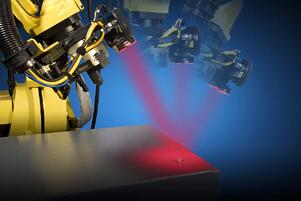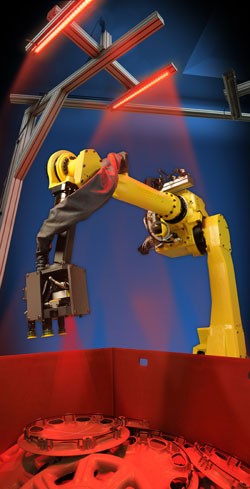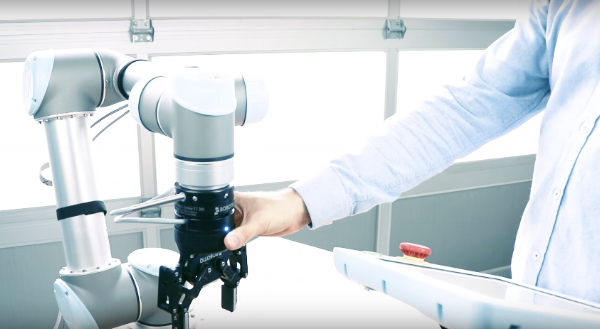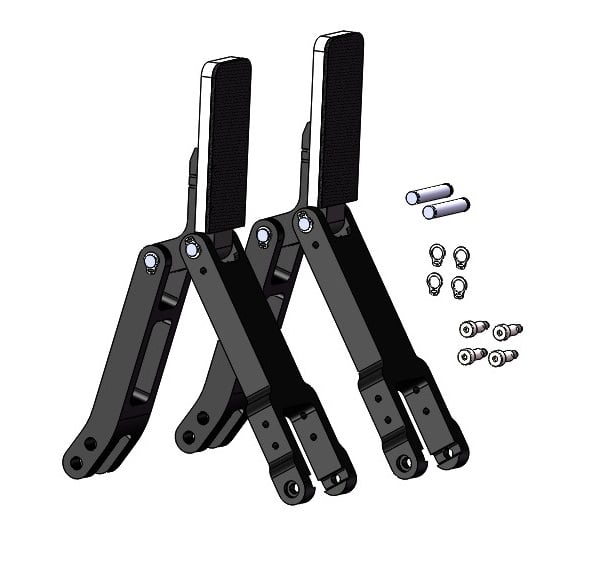Vision Guided Robotics : Enabling New Applications

Posted on Jul 10, 2013 11:28 AM. 3 min read time

When robotics are incorporated into manufacturing processes, monotonous and repetitive tasks are the first ones to be automated. The industry is still evolving and manufactures have greater demands for adaptability. In order to incorporate robots and create flexible manufacturing; sensing, and more specifically vision, is key. Vision systems are already deployed on the factory floor, but many opportunities are still open and untapped. Vision Guided Robotics (VGR) still have many promises to fulfill.
Flexibility
Manufactures want their processes to be more flexible in order to be able to reduce tooling costs and production time. Using vision can replace a lot of expensive tooling and fixtures, because the robot is able to locate the piece and pick it up by itself. The number of changeovers is therefore reduce and low cost generic bins and conveyors can be use to feed the robot. Of course, to be able to grab any piece, manufacturers can combine adaptive end effectors.
Applications
Giving eyes to robots can improve actual robotic applications such as: bin picking, machine tending and welding.
Bin picking is still a big challenge for many industries, because there are a lot of random factors, like the position of each part and the change of position when one is picked up. So, a camera is needed to detect the pieces in the bin and it has to take pictures after each pick in order to adjust to any changes.
Machine tending can be made much more flexible with the use of a vision system. A robot can detect a part in a bin, pick it up, measure the position of the machine's chuck and adjust its trajectory accordingly to fix the part in the machine, without human intervention.
Welding is another application that can be greatly improved with vision. The company Servo-Robot is providing laser vision sensing systems to improve weld quality. Their system can precisely locate the joint to weld with one or more searches. This is called; Seam Finding or Joint Finding. Then, the weld can be adjusted in real-time with their Seam Tracking or Joint Tracking feature. The system tracks the joint just ahead of where the weld is deposited. This allows not only for trajectory adjustment, but also to adjust other welding features such as: voltage, wire feed or travel speed. This system can give great welding results and reduce waste.
These examples of applications are just a small sample of what a vision system could improve. Other applications that could also benefit from this technology include packaging, and quality control.
2D or 3D?
According to the tasks either 2D or 3D cameras can be used. A 2D camera will find the part in the X, Y plane and detect its orientation. Its position in the Z axis will be calculate by the change in part size. For example, if it moves closer to the camera, its size will increase, so the change in distance can be calculated. However, those calculations are approximative and errors can occur. A 3D camera will locate the part exactly in the X, Y, Z space.

How to integrate with your robot?
Many robot manufacturers have integrated vision packages. Here are some of them:
ABB offers PickMaster a packaged solution for vision guided robotics. Different options are available such as conveyor tracking, palletizing applications and picking.
Motoman offers Cognex, an integrated vision solution for their customers. Whether in 2D or 3D, their system enables many applications such as part location, flexible part feeding, inspection or environmental perception.
Fanuc has developed an integrated vision system, iRVision, for their robot controller. Their solutions include 2D or 3D vision guidance, tracking, depalletizing and more.
These systems could facilitate implementation of vision on the shop floor and manufacturers could benefit from this new technology in the near future.
See also : How To Choose The Right Robotic Gripper For Your Application








Leave a comment